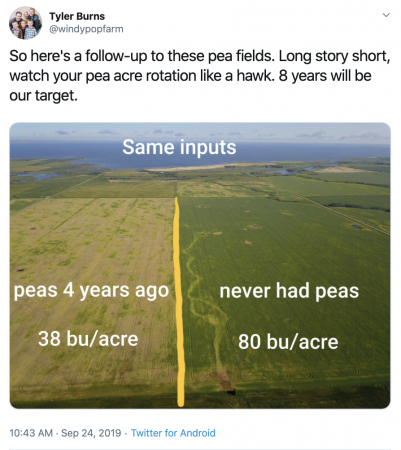
Picture this: on one side of a field is a thriving pea crop, and on the other, a pea crop that is clearly struggling. I recently stumbled upon an image like this shared by Tyler Burns (@windypopfarm) on Twitter. The left side of the pea field was yellowish in colour, recording a yield of 38 bushels per acre (bu/ac), while the right side was green and recorded 80 bu/ac. The left side had grown peas four years prior and the right side – the higher-yielding side – had never grown peas.
Burns, who farms near Kandahar, Sask., attributes the difference in yield to aphanomyces. A relatively new root rot disease, aphanomyces has already made its impact known, paralyzing peas since it was discovered in Saskatchewan in 2012, Alberta in 2013, and more recently, Manitoba in 2016. There are very limited management options available besides rotation, which makes rotation all the more important.
There are many factors that contribute to a crop rotation decision: maintaining a level of diversity, nutrient management, herbicide carryover concerns, disease concerns, weed concerns, herbicide-resistance considerations, and so on. For some of these concerns, rotation makes all the difference. But there are other factors that come into play that defy facts, like history, legacy and attachment to a crop.
In a Financial Post column entitled, “Why it’s so hard for Canadian farmers to quit growing canola – even amid blockages from China,” author Toban Dyck shared another factor that influences crop rotation: memories. His farm hasn’t grown edible beans since a poor crop “left an indelible impression on the farm’s memory.” He doesn’t downplay the role of science, but instead creates space for “stories, anecdotes, experiences and gut feelings” to enter the rotation discussion.
This prompted me to ask Burns if he was turned off from growing peas again after a poor crop. Despite the stark yield contrast present in the fields, Burns says he will continue going peas. “We should be able to do an eight-year rotation; that should help, but we need to be more vigilant about it,” Burns shares.
While it won’t be the case for Burns, there could be many producers out there who will never add a particular crop into the rotation for reasons that go beyond science and agronomy. It’s like refusing to eat a dish that gave you food poisoning in the past: I can live without carbonara when there are more than enough other options – or crops – to work with instead.
Experience is an invaluable asset to have when choosing rotations. I hope as you plan ahead you find the research included in this issue to be helpful. Whether it’s better understanding how blackleg works on the Prairies (page 36) to managing clubroot biosecurity (page 12), these stories shouldn’t dictate how you make decisions, but add to your arsenal of resources.
